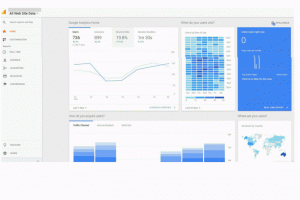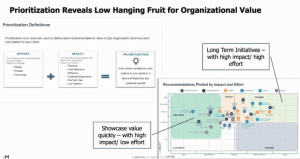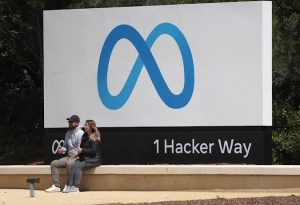Rachel Edwards on her journey in digital asset management and helping marketers find what they need with the perfect balance of metadata.
In this series, we dig deeper into the stories of our expert contributors. This interview has been edited for clarity and length.
Rachel Edwards is an experienced digital asset manager currently serving as enterprise DAM manager for W. L. Gore & Associates. Rachel is a valued contributor to MarTech, where she offers her expertise on such matters as digital asset management (DAM) implementation and DAM governance. We spoke about her journey from studying Library Science to asset management in TV and for big brands and enterprises.
Q: How did you get into marketing? Did you have any interests before getting into the profession?
A: So, primarily, I consider myself a DAM person. And it’s funny, I don’t consider myself “in marketing” because every time I work for a different company, they kind of put me in a different place. So, sometimes I’m in the marketing department — sometimes I’m in the IT department. Right now I’m in the digital studio at Gore. I tend to be the only one at these companies that does what I do, so they often don’t know where to put me. I always say, “I don’t care where you put me, I know what I need to do.” [laughs]
How did I get into the DAM space? I was actually getting a degree in Library Science without really knowing exactly what I wanted to do. I loved research, I loved libraries, but there were a lot of places to go in a library. I knew I didn’t want to be a children’s librarian, for instance. So I was just taking a wide variety of courses. This was back in the early 2000s when digital libraries weren’t as big of a thing. We took a lot of courses that assumed you’d be sitting at a reference desk, working with the public, or working in a school. But I took a couple of digital library classes and really loved them. I really clicked with how the information was organized, the whole taxonomy piece, metadata. So I took as many courses as I could.
Q: What was your first job like in the DAM space?
A: When I graduated, I got a position working at QVC, working on their Intranet site — handling the site map, the taxonomy and how the content was organized. And they were starting a program for a MAM system — a media asset management system, essentially a DAM for videos. Someone else was working on that project, but she was about to go on maternity leave. They asked if I could just fill in for a few weeks while she was out and then they’d transition it back to her. And I just loved that work. Classifying the videos, and coming up with the metadata schema. I thought I was going to be really sad to hand this back to [my colleague] when she came back. And then I got word that she wasn’t coming back from maternity leave, would I like to continue on this work? Yes! I wasn’t aware of the career options and suddenly the perfect one was handed to me.
Q: What kind of tasks were they looking for at QVC?
A: QVC basically had no system for classifying and organizing their videos at that time. So it was really starting from scratch. Coming up with the folder structure, and the taxonomy to organize these videos. And then, what metadata needs to go on them? It was producers looking for old clips to reuse, but it was also the legal department looking for something within a certain amount of time when there’s an issue. It’s about the process for ingesting the asset, putting on the metadata — who, what, when, where, how — and really starting from scratch. They not only had prerecorded video that runs during the show, but they also recorded all the 24/7 live shows — so those all had to have metadata on them as well. And metadata is my favorite part of digital asset management, I just have to say.
Q: And why is that?
A: I just love helping to find what people need as quickly as I can. And I find it’s an art. Too much metadata is overwhelming. It’s not helpful because it takes too much time to put in. And not enough means you’re not finding something that you need when you need it. So it’s kind of finding that fine, perfect balance. And, I’ll tell you, I love a controlled vocabulary. It’s the most beautiful thing on the planet to me. [Laughs]. And then you need to tie in your acronyms. It’s just seeing all the pieces come together. And someone putting in that keyword and getting exactly what they want when they want it is just…I love it. I think it’s the compartmentalization and organization aspect. My brain just thrives on that.
Q: In physical libraries, there’s usually an established system for organizing, but with digital asset management it seems like you have a hand in inventing that system.
A: There’s so much more flexibility when it’s not a physical book on a shelf because that one book has to go in one place. But when you have a digital file it could be shared in multiple places in multiple ways. And if you have different audiences looking for that same asset, they can have different metadata schemas that apply to how they’re searching. Like an IT person is going to search for something in an entirely different way than a graphic designer. They’re looking for different things but they want that same asset. You want to be able to accommodate the searching habits of all those people.
I found that library school was great for, here’s the best practices, here’s what’s recommended and generally accepted that you do. Best practices are best practices for a reason, of course. Once you get in a real-world setting, sometimes you’ve got to be flexible. You can’t force a best practice if it’s not working. So that’s a fun part of the job too. We’ve tried the best practices but they’re not working here. Now, let’s talk to people and figure out exactly what’s going to fill their needs.
Q: In your role at QVC the focus was on broadcasting. How did asset management work in your other roles?
A: My next job was at Campbell Soup, and I transitioned from managing a strict MAM system, only for video, to a DAM system, which was videos, PDFs and marketing images. It was the same, but it was different. [Laughs.] It was different metadata and a different audience. That was where I learned a lot about marketing because I did sit in the marketing department at Campbell’s. And my main audience for using that DAM system was the marketing teams at the different brands — Pepperidge Farm, and also they owned Bolthouse Farms at the time. (Campbell’s sold Bolthouse Farms in 2019.) You had a lot of different brands and a lot of different types of materials, and different ways of working and searching. It was about getting them all to share one system and make this work for everybody.
Just sitting in the marketing department, I learned so much I didn’t know about marketing. There was so much more behind search engine optimization than I ever imagined. You understand that the marketing teams are your primary audience and they are looking for things for a certain purpose. Seasons were a big thing at Campbell’s because, oh my goodness, the green bean casserole at Thanksgiving! There were certain things you knew marketers would be looking for at a given time of year. It was also the first time I worked on packaging assets. It’s a whole different taxonomy and set of metadata. All in one system, so how do I keep this from being a junk drawer?
Q: How has your work changed in recent years with media fragmentation and new channels?
A: It’s challenging to keep up with all the new systems and all the new ways for getting content out to people because I’m not just serving an internal stakeholder anymore. Marketers want the DAM system integrated into these other systems to push their assets right out of the DAM system directly to customers. This is great for efficiency, but also a challenge in determining what metadata goes with the assets. Do we need to make any changes in the metadata we’re capturing in the DAM to make it optimal for these other systems? You don’t want to add too many metadata tags that are elusive to a single system because now you’ve got this huge metadata set. Too much can be as unhelpful as too little metadata. What are the key pieces of metadata the system needs that I can map across it?
This is where an analytics dashboard helps because I can see what people are putting into the search box and coming up with zero results. Is it just a misspelling I need to accommodate? Are they using an acronym versus the full term? That’s not a good user experience. And on the flip side, if they’re putting in a search term and getting 5,000 results, that’s also not terribly helpful. So, analytics helps confirm that I have the right search filters in place.
Q: What kind of role are you in now?
A: At Gore, I currently sit within an enterprise IT system. I’m there because Gore has a number of separate divisions, and each division has to sign off if someone wants to use an asset. There’s very rarely a “no, absolutely not.” They’re great at finding a solution that will work, but it can be challenging with an enterprise system. I’ve worked in places where everything was a fight, and that makes my job a bit harder!
Q: It sounds like even though you’re talking about taxonomy and digital assets, there’s also a people element.
A: Definitely. And that’s the biggest variable. I have control over the taxonomy, I have control over the metadata — and even the assets, to some extent. But the people vary widely, so you have to kind of let go, to some extent, the people-pleasing part of your brain. I can’t make everybody happy all of the time. I have to think about what’s going to bring the greatest value to the greatest number of users in the system.
The post Rachel Edwards: Spotlight on the expert appeared first on MarTech.
MarTech(0)





